Overview
A boundary is a line or surface which delineates the horizontal or vertical extent of a parcel of land. A boundary can be represented by a right-line, an arc, or an irregular line, and the term ‘boundary’ can also refer to permanent structures such as fences and walls, or natural features such as ridge lines, banks of rivers, or tidal margins.
Boundaries can be movable (ambulatory), as in the case of water boundaries, or fixed, as in the case of boundaries delineated by monuments placed in the ground or permanent structures. This guidance relates to different forms of fixed boundaries commonly used in New Zealand.
Key terms
For key terms relating to boundaries, see Schedule 2 of the CSR 2021.
Right-line boundaries
A right-line boundary must follow the shortest distance between two boundary points (r 7).
Right-line boundaries only for horizontal extent of parcel
A right-line boundary may be used to define the horizontal extent of a primary or non-primary parcel boundary, but not the vertical extent (r 38 and r 46).
Length and direction of line expressed as vector
The length and direction of a right-line boundary is required to be shown on a title diagram as a vector comprising a bearing and distance (r 105(1)(a)). However, this does not apply to:
- an existing non-primary parcel boundary already defined in an approved CSD (r 105(2)(a))
- a boundary that is accepted (r 105(2)(b))
- an inaccurately determined boundary that coincides with the underlying parcel boundary (r 105(2)(c)).
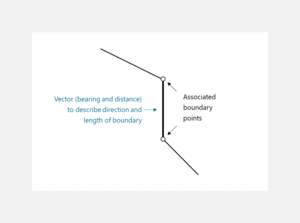
Figure 1: Example of vector to describe length and direction
Arc boundaries
An arc boundary must follow part of the circumference of a horizontal circle (r 8).
Arc boundaries only for horizontal extent of parcel
An arc boundary may be used to define the horizontal extent of a primary or non-primary parcel boundary but not the vertical extent (r 38 and r 46).
Size and location of arc line expressed as a chord bearing
The size and location of an arc boundary is required to be shown on a title diagram, and the chord bearing, arc distance, and radius of the arc boundary must be included (r 105(1)(b)). The chord bearing, arc distance, and radius may be included as a user-added annotation.
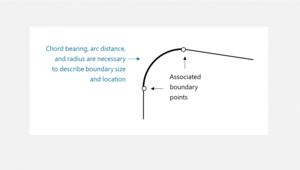
Figure 2: Example of arc boundary
Irregular boundaries
An irregular boundary must follow an irregular (or wavy) line (r 9(1)).
The use of irregular boundaries is restricted under the CSR 2021. This means that new irregular boundaries must not be created, and existing irregular boundaries must be converted to right-lines, unless expressly allowed to be used in certain circumstances (r 9(2) and (3)).
Where new irregular boundaries are permitted
New irregular boundaries are only permitted in the following circumstances:
- A new non-primary parcel boundary which coincides with an existing irregular primary parcel boundary which will remain as an irregular boundary after survey (r 46(3)).
- The landward boundary of a movable marginal strip or esplanade strip (r 46(4)).
- A new non-primary parcel boundary which coincides with the irregular landward boundary of a movable marginal strip or esplanade strip (r 46(5)).
- An existing water boundary where the physical margin of the water body has moved but the documentary boundary has not moved (r 10(3)(a)).
Where existing irregular boundaries may remain as irregular boundaries
Existing irregular boundaries may remain as irregular boundaries in a new CSD in the following circumstances:
- An existing irregular boundary that is part of a new primary parcel accepted under rule 15(2). In this case:
- there must be no risk of the boundary encroaching on another parcel (r 15(2)(a))
- the boundary must be part of a new primary parcel over 20 ha, comprising more than 80 percent of the existing primary parcel being extinguished (r15(2)(b))
- the boundary is part of the balance of a title that is to remain limited as to parcels or remain a Hawke’s Bay interim title and its boundary points do not meet class C boundary accuracies (r 15(2)(c)(iii)), or the boundary is an existing irregular boundary (r 15(2)(c)(v)).
- An existing irregular boundary that is part of a new balance or residue parcel, where the irregular boundary and boundary points are not common with another new parcel on the same survey, accepted under rule 15(3).
- An existing irregular boundary and its associated boundary points that are part of a new primary parcel over 100 ha, and are not in common with another parcel on the same survey that is 100 ha or less, accepted under rule 15(4).
- An existing irregular boundary that is part of a new primary parcel over 20 ha comprising more than 80 percent of the existing primary parcel being extinguished (r 9(3)(b)(i)).
- An existing irregular boundary that is part of a new primary parcel over 100 ha (r 9(3)(b)(ii)).
- An existing irregular boundary which was previously a water boundary and has previously been treated as an irregular boundary in accordance with rule 10(3)(a) (r 9(3)(c)).
- An existing irregular boundary which bounds a non-primary parcel (r 46(6)).
An existing irregular boundary that followed the centre-line of a water body may be adopted in its previously defined position as a water centre-line boundary (r 11(2)). In all other cases, an existing irregular primary parcel boundary must be converted to right-lines (r 9(3)).
Refer to Water centre-line boundaries for further information.
Requirements where irregular boundaries are converted to right-lines
Irregular boundaries that have been converted to right-lines must be defined by survey (r 13(c)). Conversion to right-lines results in the creation of new boundary points. For a class A right-line boundary on a new primary parcel, the new boundary points must be marked on the ground if practicable (r 35(1)).
Adequacy of definition where irregular boundaries are converted to right-lines
When an existing irregular or water centre-line boundary is converted to right-lines, the location of the new right-line boundary must be determined to appropriate accuracy. The existing boundary must not be copied from Landonline without verification that it is in the correct position.
Verification involves determining the correct shape of the boundary at the time it was surveyed. This may require digitisation of the boundary from the source CSD or determination of the boundary from field notes or aerial photography dating from the time of the survey.
If the irregular or water centre-line boundary is depicted on the source plan at a scale that is not sufficiently accurate for determining the location of the new fixed right-line boundary, determination from field notes or aerial photography may be preferable to digitisation of the boundary from the source CSD.
If an existing irregular boundary was defined by offsets from an adjoining water boundary, and the margin of the water body has not moved since the irregular boundary was originally defined, it may be appropriate to define the irregular boundary by a better survey fix of the water body.
For further information about this process, see:
Water boundaries guideline on Better Survey Fix.
Regardless of the technique used to define the boundary, the survey report should include details of the accuracy of irregular or water centre-line boundaries and the method used to define them (r 72(k), r 72(o), and see also r 29).
Examples of existing irregular boundaries
The majority of existing irregular boundaries in the cadastre are associated with older surveys where fixed marginal strips, reserves for public purposes, or roads are offset from the edge of waterways. Large rural parcels defined on early Crown land plans, particularly in the South Island, were often bounded by irregular boundaries following natural features such as ridge lines, bush edges, or cliffs. Roads which run through large rural parcels created on early survey plans may also be bounded by irregular boundaries.
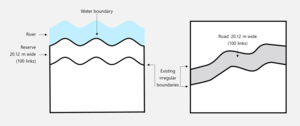
Figure 3: Examples of existing irregular boundaries
Water boundaries
Water centre-line boundaries
A water centre-line boundary follows the line midway between the landward margins of a stream or river bed (r 11(1)). Surveyors have usually treated water centre-line boundaries as fixed – meaning they do not move together with the banks and bed of a water body when accretion or erosion occurs. However recent research has suggested that this approach may have been based on an incorrect interpretation of a New South Wales Court case, In re White (1927) 27 SR (NSW) 129. The CSR 2021 recognise water centre-line boundaries as a new type of boundary but are silent on whether they are fixed or not. When a survey is affected by an existing water centre-line boundary the intent to ‘fix’ that boundary, or not, at the time it was created needs to be carefully examined.
New water centre-line boundaries cannot be created (r 11(3)).
Examples of existing water centre-line boundaries
To be considered a water centre-line boundary, the survey plan on which the boundary was originally defined must show a clear intention for the boundary to follow the centre-line of the water body.
Water centre-line boundaries are likely to be found on older Land Transfer or Māori Land (LT, DP or ML) plans and are expressly shown or described as extending to the centre of the water body.
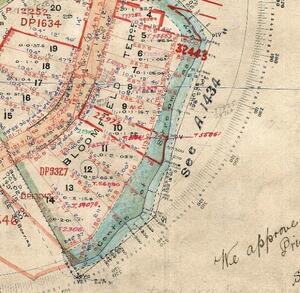
Figure 4: DP 1548 (Wellington) has an example of a stream which is intended to be a water centre-line boundary. An annotation is included stating 'Centre of Stream as Bdy'.
Historically, small-scale Survey Office (SO) plans which subdivided large rural parcels for settlement often depicted streams as single lines with an annotation for the stream name. Streams were usually depicted in this manner to simplify plan draughting, rather than to indicate that the boundary was intended to follow the centre-line of the stream.
If streams depicted as single lines coincide with parcel boundaries, but the relevant plan does not have annotations or diagram enlargements that confirm whether the boundary follows the bank or the centre-line of the stream, the field notes and associated estate records, such as current and historic titles and Crown grants, should be checked to see if they contain further information. If the field notes do not contain any relevant information, the boundary should be presumed to be the near bank of the stream rather than the centre-line.
Irregular centre-line boundary may be treated as a water centre-line boundary
In the past, survey rules and regulations have required water centre-line boundaries to be treated as irregular boundaries and, in many cases, right-lined.
Under the CSR 2021, an existing irregular boundary that followed, or follows, the centre-line of a water body may be adopted in its previously defined position as a water centre-line boundary (r 11(2)).
The boundary must be annotated on the survey and title diagrams as following the centre-line (r 88, r 104).
Accuracy of irregular and water centre-line boundaries
Accuracy classes do not apply to irregular and water centre-line boundaries (r 29(1)).
Despite this, new and adopted irregular or water centre-line boundaries must meet the accuracy criteria of rule 29(2).
An irregular or water centre-line boundary accepted under rule 15 is not required to comply with the accuracy requirements of rule 29(2). Examples where this occurs include:
- a water centre-line boundary for a parcel that will remain in a limited title or a Hawke’s Bay interim title (r 15(2)(c)(iv))
- an existing irregular boundary (r 15(2)(c)(v))
- an existing irregular or water centre-line boundary for a balance parcel or residue parcel that is not common with another new parcel on the survey (r 15(3))
- an existing irregular or water centre-line boundary for a parcel over 100 ha, which is not common with another parcel on the same survey which is 100 ha or less (r 15(4)).
Information about the accuracy of an irregular or water centre-line boundary, and the factors considered for the determination of that boundary, as specified in rule 29(2), must be included in the survey report (r 72(k)). This information is not necessary for an irregular or water centre-line boundary which is accepted.
Accuracy of intersection of right-line and irregular/water centre-line boundaries
In instances where a right-line boundary and an irregular or water centre-line boundary intersect:
- the bearing of the right-line boundary must meet the accuracy standards specified in rule 27(1) for class A, B, or C accuracies, as appropriate (r 30(a))
- the distance of the right-line boundary must match the accuracy of the irregular or water centre-line boundary as determined under rule 29(2), and must be class D (r 30(b)).
In order to comply with rule 30, these right-line boundaries must be captured in Landonline as class AD, BD, or CD, where the first letter represents the bearing accuracy class and the second letter represents the distance accuracy class.
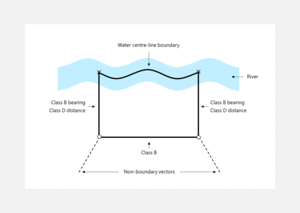
Figure 5: Examples of intersection of right-line and irregular/water centre-line boundaries
Special requirements for parcels with irregular or water centre-line boundaries
Boundary reinstatement surveys must not be used to reinstate the position of a boundary point forming part of a water centre-line or irregular boundary (r 114(1)(a)).
If a water centre-line boundary affected by ground movement is to be retained under rule 11(2), it must be accepted rather than adopted (r 109(5)).
Treatment of irregular and water centre-line boundaries in Landonline
Capture of irregular and water centre-line boundaries
For information about capture of irregular and water centre-line boundaries in Landonline, see the following.
- Irregular Lines (New Landonline).
- Capture – irregular boundaries (Legacy Landonline).
- Irregular boundaries – splitting (Legacy Landonline).
- Irregular boundaries not displaying in Layout Sheets (Legacy Landonline).
For information about annotation of irregular and water centre-line boundaries in Landonline, see:
- Edit irregular boundary attributes (New Landonline)
- Water, water centre-line and irregular boundary annotation (Legacy Landonline).
Capture of connections to irregular and water centre-line boundaries
In some cases, existing irregular or water centre-line boundaries are not accurately depicted in Landonline. As such, they must not be copied from Landonline without verification that they are in the correct position.
Verification involves determining the correct shape of the boundary at the time it was surveyed. This may require digitisation of the boundary from the source CSD or determination of the boundary from field notes or aerial photography dating from the time of the survey.
Verification using these techniques may involve the capture of ties or offsets to intermediate points. While these ties may be valuable for the accurate adoption of the boundary, the CSR 2021 do not require them to be included in the CSD.
If a surveyor chooses to capture ties to intermediate points in a CSD, separate irregular or water centre-line boundaries should be created between adjacent intermediate points, rather than having a single line that passes over them. The intermediate points are to be considered as end points for the purposes of rule 89(e) and need to have a minimum of one vector connected to them.
The survey report should include details of the accuracy of irregular or water centre-line boundaries and the method used to define them (r 72(k), r 72(o), and see also r 29).
Recording irregular and water centre-line boundaries to scale on survey diagrams and title diagrams
On a survey diagram and title diagram an irregular or water centre-line boundary must be depicted to show its true shape and relationship to other boundaries (r 85(a) and r 100), and
Where information that is to scale is unclear or ambiguous (for example, a long narrow parcel where an irregular boundary and an adjoining stream boundary appear to merge), these boundaries may be shown as distorted in separate diagrams.
On a survey diagram, the scale must be adequate to meet the accuracy requirements of rule 29(2) (r 85(b)).